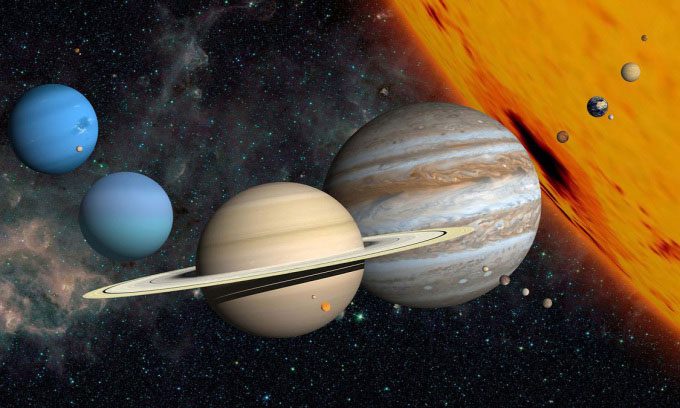If a celestial body accumulates enough mass, it will attract material toward its center due to gravitational force, organizing the material until it forms a sphere.
Thanks to telescopes on Earth and in space, astronomers can observe distant areas of the universe. No matter how far or strange these areas may be, one thing seems to hold true: there are many spherical celestial bodies.

Many planets in the universe are spherical. (Photo: Ron Miller/Stocktrek Images).
“It’s fascinating that so many things in space that humans know of are spherical,” Live Science quoted Anjali Tripathi, an astrophysicist in NASA’s Exoplanet Exploration Program, working at the Jet Propulsion Laboratory in California, on November 13.
The rounding effect comes from “self-gravity,” the gravitational force that a body— in this case, a celestial body—exerts on itself. When a planet or moon accumulates enough mass, its self-gravity will “mold” it into a spherical shape.
Celestial objects form after the Big Bang occurred, which happened about 13.8 billion years ago. Tiny dust particles move within massive dust clouds shaped like donut rings and begin to collide with each other. According to NASA, if the collision is gentle enough, the dust particles will merge. Successive collisions create a snowball effect: as a planet accumulates more mass during its formation, its gravitational pull increases, attracting even more material.
“Gravity pulls all material toward the center. Just like a kitchen sink, all the water will flow down the drain. In the case of planets, every piece of material tries to get as close to the center as possible,” explains astronomer Bruno Merin, head of the ESAC Science Data Centre at the European Space Agency.
Planets will continue to relocate surrounding material until they reach a state of equilibrium, a state where everything is as close to the center as possible. The only shape that achieves such equilibrium in space is a sphere, Merin stated.
Mercury and Venus are nearly perfect spheres because they are slow-rotating rocky planets. Ice planets also tend to be nearly perfectly round because the ice layer is distributed very evenly, Merin noted.
However, not all planets are perfectly spherical. The two gas giants, Jupiter and Saturn, bulge at the equator due to their rapid rotation. NASA describes Saturn as looking like a basketball being sat on. Earth also slightly bulges, by less than 1%, due to centrifugal force—the outward force experienced by a rotating object. Therefore, Earth has an oblate spheroid shape.
The universe has many spheres, but some objects are not round at all. Asteroids and comets can take any shape due to being shaped by collisions and rotation in interstellar space. Mars has a moon shaped like a potato named Phobos. In fact, only about 20 of the nearly 300 known moons in the Solar System are spherical; the rest have more irregular shapes. Tripathi explained that the small mass means they do not possess enough gravitational force to create a uniformly round shape.


















































